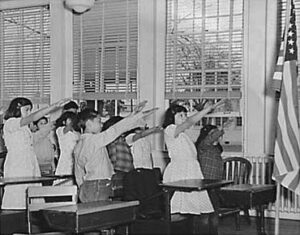Pledge of Allegiance
The Pledge of Allegiance was written in September of 1892 by Baptist minister Francis Bellamy for “The Youth’s Companion” magazine in Boston. Copies were printed on leaflets and sent to schools throughout the United States. It was well received. On the morning of September 8, 1892, more than 150 newspapers published it. It’s first widespread use was on Oct. 12, 1892, when as many as 12 million school children recited it to celebrate the 400-year anniversary of Columbus’ discovery of America.

There’s a strange side note too, the magazine was published by the Perry Mason Company in Boston. Detective story author Earl Stanley Gardner was very fond of The Youth’s Companion as a child, and … you guessed it … he named his detective hero Perry Mason.
According to the Flag Code, the Pledge “should be rendered by standing at attention facing the flag with the right hand over the heart. When not in uniform men should remove any non-religious headdress with their right hand and hold it at the left shoulder, the hand being over the heart. Persons in uniform should remain silent, face the flag, and render the military salute.”
The Bellamy Salute

For almost 50 years, recital of the Pledge was accompanied by what was called the Bellamy Salute, in honor of Francis Bellamy. It was right arm out, palm down, eye level salute. Unfortunately, in the late 1920s, Italian Fascists and Nazi Germans adopted a similar salute. The Bellamy Salute was replaced by the now familiar hand over the heart salute on December 22, 1942.
Bellamy wrote The Pledge of Allegiance to be brief and to the point, 15 seconds max. There have been several notable changes to The Pledge of Allegiance over the years. The original pledge was to “my flag”, later in 1923 it was changed to “the Flag of the United States” and still again in 1924 to “the Flag of the United States of America”. The most controversial change was in 1954 when the words “under god” were added. Here’s The Pledge of Allegiance as it stands today:
“I pledge allegiance to the Flag, of the United States of America and to the Republic for which it stands, One Nation under God Indivisible, with Liberty and Justice for All.”